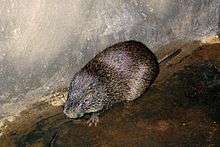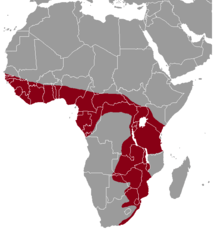Greater cane rat
| Greater cane rat | |
|---|---|
 | |
| Scientific classification | |
| Kingdom: | Animalia |
| Phylum: | Chordata |
| Class: | Mammalia |
| Order: | Rodentia |
| Family: | Thryonomyidae |
| Genus: | Thryonomys |
| Species: | T. swinderianus |
| Binomial name | |
| Thryonomys swinderianus (Temminck, 1827) | |
 | |
The greater cane rat (Thryonomys swinderianus) is one of two species of cane rats, a small family of African hystricognath rodents.[2] The cane rat lives by reed-beds and riverbanks in Sub-Saharan Africa. Cane rats can grow to nearly 60 cm (2.0 ft) in length and weigh a little less than 8.5 kg (19 lb). It has rounded ears, a short nose, and coarse bristly hair. Its forefeet are smaller than its hind feet, each with three toes.
Cane rats live in small groups led by a single male. They are nocturnal and make nests from grasses or burrow underground. Individuals of the species may live in excess of four years. If frightened, they grunt and run towards water. So far, their conservation status is lower risk.
As humans expanded into the cane rat's native habitats, the cane rats likewise expanded from their native reeds into the plantations, particularly the sugar cane plantations from which they derive their name. Their tendency to adopt plantations as habitat, where they feed on agricultural crops such as maize, wheat, sugar-cane and cassava, often earns them the label of agricultural pest. However, the peoples of the region also utilize the cane rat as a food source (as bushmeat), considering the meat a delicacy. Consequently, grasscutters (as they are often called in Ghana, Nigeria and other regions of West Africa) are beginning to be raised in cages for sale.[3]
References
| Wikispecies has information related to Thryonomys swinderianus |
| Wikimedia Commons has media related to Thryonomys swinderianus. |
- ↑ Hoffmann, M. (2008). "Thryonomys swinderianus". IUCN Red List of Threatened Species. Version 2013.1. International Union for Conservation of Nature. Retrieved 2013-09-08.
- ↑ Woods, C.A.; Kilpatrick, C.W. (2005). "Infraorder Hystricognathi". In Wilson, D.E.; Reeder, D.M. Mammal Species of the World: A Taxonomic and Geographic Reference (3rd ed.). Johns Hopkins University Press. p. 1545. ISBN 978-0-8018-8221-0. OCLC 62265494.
- ↑ micro-livestock Micro-livestock: Appropedia - Little-known Small Animals with a Promising Economic Future 7
- Matthews, Jaman. "The Value of Grasscutters," World Ark, (January–February, 2008), pp. 23–24.
